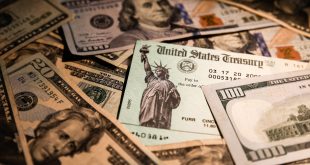The US dollar achieved strong gains in the last trading week, driven by a series of strong US economic data, with the markets increasing expectations that the US Federal Reserve will continue its tightening approach.
In terms of weekly trading, the US dollar recorded a strong rise in today’s trading, heading towards recording remarkable weekly gains for the third consecutive week; As the total dollar gains since the first sessions of the week until now were estimated at approximately 1.00%.
The dollar fell against the euro and the pound sterling on Friday as the market regrouped ahead of a long weekend and awaited indications of the Federal Reserve’s plan to continue combating still-high inflation.
The dollar index fell in its latest trading by 0.24 percent to 103.83, after earlier reaching 104.67, its highest level since January 6.
The pound rose 0.48 percent to $1.2044, while the euro rose 0.22 percent to $1.0696, after falling earlier to
$1.06125, its lowest since January 6.
Data
The US Bureau of Labor Statistics reported that inflation in the United States, as measured by the Consumer Price Index (CPI), declined to 6.4% on a yearly basis in January from 6.5% in December. Came in higher than the market expectation of 6.2%.
On a monthly basis, the CPI was up 0.5%, matching analysts’ estimates. The Core CPI, which excludes volatile food and energy prices, rose 0.4% on a monthly basis as expected, bringing the annual rate down to 5.6% from 5.7%.
The Producer Price Index (PPI) for final demand in the US declined to 6% on a yearly basis in January from 6.5% in December, the data published by the US Bureau of Labor Statistics revealed on Thursday. This reading came in higher than the market expectation of 5.4%.
The annual Core PPI edged lower to 5.4% in the same period from 5.5%, compared to analysts’ estimate of 4.9%. On a monthly basis, the Core PPI came in at 0.5%.
The UK annualized Consumer Prices Index (CPI) came in at 10.1% in January against the 10.5% increase recorded in December while missing estimates of a 10.3% print, the UK Office for National Statistics (ONS) reported on Wednesday. The index keeps moving away from its highest level since January 1981, reached at 11.1% last year.
Meanwhile, the Core CPI gauge (excluding volatile food and energy items) eased to 5.8% YoY last month versus 6.3% seen in December. The market consensus was for a 6.2% print.
The monthly figures showed that the UK consumer prices declined by 0.6% in January vs. -0.4% expectations and 0.4% prior.
The UK Retail Price Index for January stood at 0% MoM and 13.4% YoY, beating expectations across the time horizon.
Oil
Oil settled down by $2 a barrel on Friday and ended the week lower as traders feared demand would be affected by any future hike in US interest rates and were nervous about growing signs of ample supplies of crude and fuel.
Two Federal Reserve officials warned on Thursday that more measures are needed to raise borrowing rates to rein in inflation. The dollar rose on sentiment, making oil more expensive for holders of other currencies.
Brent crude futures fell $2.14 a barrel, or 2.5 percent, to settle at $83 a barrel, bringing their losses to 3.9 percent for the week. US West Texas Intermediate crude fell $2.15, or 2.7 percent, to end trading at $76.34 a barrel, a weekly loss of 4.2 percent compared to last Friday’s closing price.
The market was also affected by a number of indicators of ample supplies.
On Friday, the Vedomosti newspaper quoted informed sources as saying that Russian oil producers expect to maintain current oil export volumes despite the government’s plan to cut oil production in March.
The latest data on US supplies on Wednesday showed that crude inventories in the week ending February 10 rose by 16.3 million barrels to 471.4 million barrels, the highest level since June 2021.
Europe
European stocks edged higher on Friday, retreating from the one-year highs touched earlier in the week, with energy and technology stocks leading losses amid growing fears that the Federal Reserve will stick to monetary tightening for a longer period.
The pan-European STOXX 600 index closed down 0.2 percent, after touching a one-year high in the previous session, supported by French blue chips.
And after recent data released in the United States, including a stronger-than-expected producer price report in January, indications have increased that the Fed’s large interest rate hikes have not yet served their purpose in cooling the economy to the degree that satisfies the central bank.
Energy stocks fell 1.9 percent, leading the Stoxx 600’s losses as crude prices fell on fears of further US interest rate hikes, which in turn affected demand.
Interest-sensitive technology stocks followed, dropping 1.7 percent.
And limiting the losses of the European index were companies in the health care, utilities and communications sectors, which gained rates ranging between 0.6 percent and 0.8 percent.
Gold
Gold headed on Friday to record a decline for the third week in a row, affected by the rise in the dollar and bond yields, after new statements tending to tighten monetary policy from officials of the Federal Reserve.
By 1658 GMT (Friday, February 18), spot gold rose 0.1% to $1839.09 an ounce, after earlier falling to its lowest since late December. The yellow metal has fallen 1.4 percent so far this week.
Federal Reserve officials said this week that the Fed should have raised interest rates more than it did earlier this month.
The dollar index jumped to a six-week high, making the precious metal less attractive to buyers holding other currencies.
Gold is a hedge against inflation, but higher interest rates increase the opportunity cost of holding non-yielding bullion.
As for other precious metals, spot silver rose 0.4 percent to $21.69 an ounce, while palladium fell 0.4 percent to $1,504.15, and platinum settled at $919.65, after earlier hitting its lowest since November.
 Noor Trends News, Technical Analysis, Educational Tools and Recommendations
Noor Trends News, Technical Analysis, Educational Tools and Recommendations





